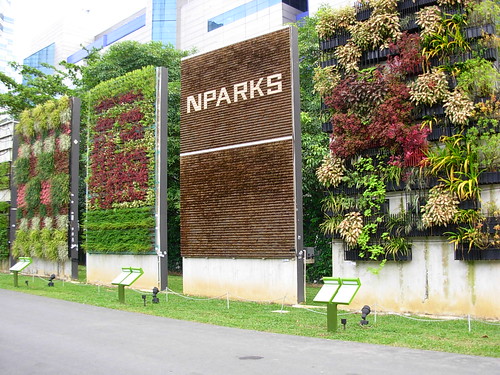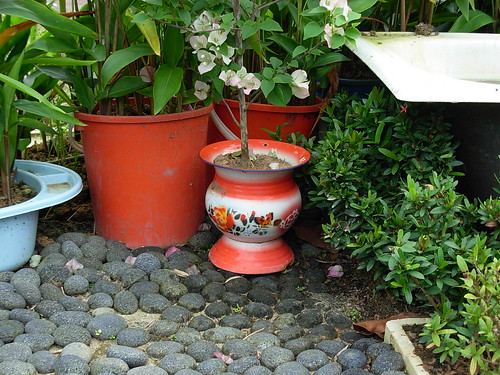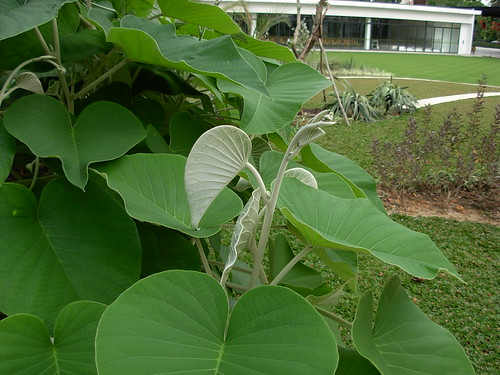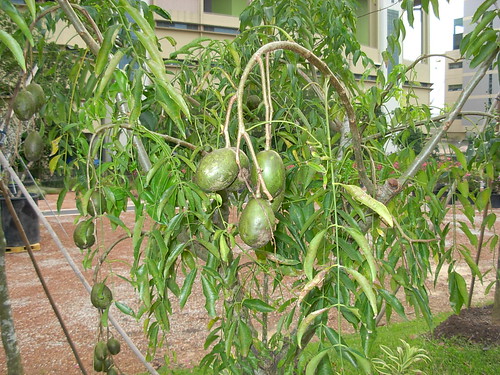
Recently, I visited the newly opened HortPark with my family. It is located at Hyderabad Road, opposite the Gillman Village. I think gardening enthusiasts would like this place. It is huge and divided into several sections each focusing on a different theme. You can see many types of gardening plants there. I think my friends John and Ann Harper would have enjoyed this place. Unfortunately, last November, when they visited Singapore, I didn’t know about this place yet. Anyway, I saw some plants there which brought back memories of my kampong days.

I like this picture (above) very much. It’s taken in the Recycling section. I wonder if young readers know what this container is. In Hokkien it’s called ‘tam pui’. British journalist, Neil Humphreys once joked that his Singaporean friends called him this name. In Cantonese, it’s ‘tam tong’. It is a spittoon. Older Chinese folks liked to use it. In fact, I read that President Nixon was surprised to find Chairman Mao Tse Tung using it during his historic visit to China. It also served as a potty for young children. In the old days, kampong folks often used metal containers and pails as flower pots. In fact, I am not surprised if some homes still do.

The second plant I noticed was an Elephant Climber (Argyreia nervosa). It has big leaves with silvery underside and purple flowers. I used to pluck the young unopened leaves to use as a book mark. We planted this creeper once and let it climb up a tall wooden frame at the side of our house. It served as a porch and garage for our car. Unfortunately, I do not have any photos of this. But in the 1969 photo below of my father, you can see part of an aluminum porch on the left. This was built to replace the wooden one with this climber.


The third plant is a kind of pomelo tree - actually I am not sure of the name. Hope readers can help. Both the tree and its fruits are much smaller than the pomelo trees I have seen at a pomelo farm in Tambun near Ipoh. What I remember most is the nice smell of the leaves and the sharp needle-like thorns. We used to pluck a few pieces of leaves and place them in a tin box to keep our prized (fighting) spiders; which is called ‘pow fu’ in Cantonese or ‘hor sin hor’ in Hokkien.

The last plant that caught my ‘nostalgic’ eyes was the buah long long which Chuck blogged about earlier. Finally, I have a photo to show you what the fruit looks like.





11 comments:
"Potty"? Have u heard about collection urine (from humans)and using to fetilise the plants or burning cut grass and burning them for top soil?
In the good days, I saw Indian men going around on a pick-up truck selling black top soil called "Telembu", a mix of burnt soil and cowdung. 1 kerosene size tin cost about 50 cents.
Most landed homes would have a small pit in the garden to burn the waste heaps. Unfortunately the government put an end to this practice in the 1970s.
Ann took one look at the photo and said "Wow! That looks really interesting."
John
Actually that potty is not only for young kids but also for old people who are not mobile but yet have to get up several times at night to go to the toilet. When my mum was old, she used to have one in her bedroom.
hi chun see,
i used to refer to the fruit by the same name 'buah long long' until someone corrected me and said it should be kedongdong. the fruit is not readily available but once in a while i can still get it from bangkit market in bukit panjang.
more people will come to know about the hortpark once the south ridges elevated walkway is open to the public as the park is located along the route.
Chun See
well the Harpers may not have been able to visit but we had better put it on the list for our visit to Spore next year, mt wife Tessa is a very keen gardener, we have a nice garden here at the house and she has a vegetable and fruit plot with my sister in law at what we call 'allotments'- several hectares of land nearby divided into many strips. Whenever we travel to Europe we inevitably have to visit garden centres and plant stalls and markets - at least we might be able to bring back some seeds.
YG. Thanks for pointing out the 'correct name' for Buah Long Long.
I have this book called 1001 Garden Plants in Spore published by Nparks. No wonder I couldn't find the Buah Long Long in it. There's an entry titled Spondias cytherea, family name - Anacardiaceae, common name - Golden Apple, Great Hog Plum and Kedondong. From the photo, it looks like our Buah Long Long. The real gardeners in my family - my wife and son - say that it is always better to use the scientific names for plants; but they are so 'long long'; and unromantic ... how to remember!
Brian. Did you know that John also has an allotment called Glen Allotments? He even has a blog here.
Next year would be a good time to visit HorPark. Now is a bit too early as several sections still under construction and the plants not in full bloom yet.
The spittoon you have in your photo is the tall type made of enamelled metal. During our era, there was also a short type (made of cast iron?) with no colourful design and did not come with the bottom "stand" that the tall one had.
Under every coffeeshop table of yesteryear, you could find a short one.
The spitton was a multi-purpose container and was especially useful in kampong days when toilet was usually in open ground. Just imagine when a person needed to ease himself in the middle of the night, would it be convenient for him to take a torchlight going all the way to the toilet. What happen if there was a snake lurking around? With the prevailing spitting culture in China, it was practical to place a spitton under the tea table, while a dialogue took place between Mao and Nixon. To the disappointment of the inquisitive journalists around, they certaining missed the spitting action.
Buah Long Long and Kedongdong is same for me. I believe it it also known as 'Bell' fruit in english. Those found in my kampung were hugh trees unlike the miniature ones. They make good lastic pratice 10 meters above ground. We used to throw the fruit on the cement path to smash it so that it can be easily eaten. There is one restuarant in KL just besides Vistana Hotel serving Kedongnong juice with cour plum. Taste great!!
I remember using a potty when young. We lived in a 2 storey shophouse. There were 3 bedrooms upstairs. The only toilet was downstairs. So there was a potty in every room. They were brought downstairs each morning for disposal.
Hi. Thanks for clearing up the buah long long mystery ! I looked up Wikipedia when I was trying to find out what the fruit is called in English - no luck. Tried "buah kedongdong" and there it was ...
Post a Comment